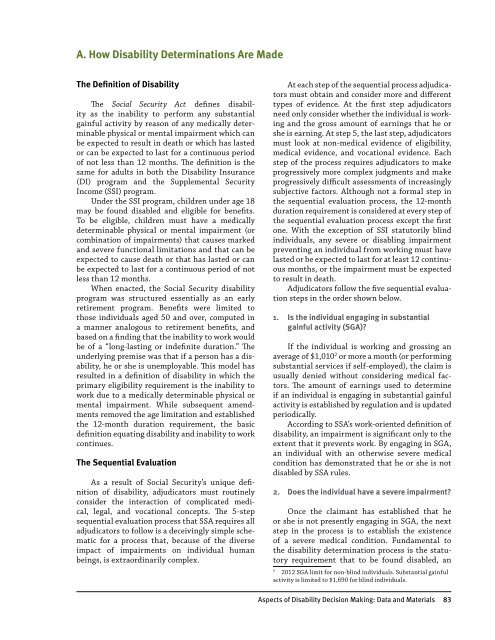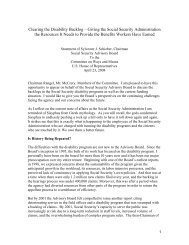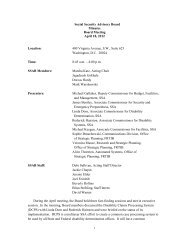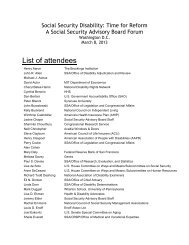Aspects of Disability Decision Making: Data and Materials
Aspects of Disability Decision Making: Data and Materials
Aspects of Disability Decision Making: Data and Materials
You also want an ePaper? Increase the reach of your titles
YUMPU automatically turns print PDFs into web optimized ePapers that Google loves.
A. How <strong>Disability</strong> Determinations Are MadeThe Definition <strong>of</strong> <strong>Disability</strong>The Social Security Act defines disabilityas the inability to perform any substantialgainful activity by reason <strong>of</strong> any medically determinablephysical or mental impairment which canbe expected to result in death or which has lastedor can be expected to last for a continuous period<strong>of</strong> not less than 12 months. The definition is thesame for adults in both the <strong>Disability</strong> Insurance(DI) program <strong>and</strong> the Supplemental SecurityIncome (SSI) program.Under the SSI program, children under age 18may be found disabled <strong>and</strong> eligible for benefits.To be eligible, children must have a medicallydeterminable physical or mental impairment (orcombination <strong>of</strong> impairments) that causes marked<strong>and</strong> severe functional limitations <strong>and</strong> that can beexpected to cause death or that has lasted or canbe expected to last for a continuous period <strong>of</strong> notless than 12 months.When enacted, the Social Security disabilityprogram was structured essentially as an earlyretirement program. Benefits were limited tothose individuals aged 50 <strong>and</strong> over, computed ina manner analogous to retirement benefits, <strong>and</strong>based on a finding that the inability to work wouldbe <strong>of</strong> a “long-lasting or indefinite duration.” Theunderlying premise was that if a person has a disability,he or she is unemployable. This model hasresulted in a definition <strong>of</strong> disability in which theprimary eligibility requirement is the inability towork due to a medically determinable physical ormental impairment. While subsequent amendmentsremoved the age limitation <strong>and</strong> establishedthe 12-month duration requirement, the basicdefinition equating disability <strong>and</strong> inability to workcontinues.The Sequential EvaluationAs a result <strong>of</strong> Social Security’s unique definition<strong>of</strong> disability, adjudicators must routinelyconsider the interaction <strong>of</strong> complicated medical,legal, <strong>and</strong> vocational concepts. The 5-stepsequential evaluation process that SSA requires alladjudicators to follow is a deceivingly simple schematicfor a process that, because <strong>of</strong> the diverseimpact <strong>of</strong> impairments on individual humanbeings, is extraordinarily complex.At each step <strong>of</strong> the sequential process adjudicatorsmust obtain <strong>and</strong> consider more <strong>and</strong> differenttypes <strong>of</strong> evidence. At the first step adjudicatorsneed only consider whether the individual is working<strong>and</strong> the gross amount <strong>of</strong> earnings that he orshe is earning. At step 5, the last step, adjudicatorsmust look at non-medical evidence <strong>of</strong> eligibility,medical evidence, <strong>and</strong> vocational evidence. Eachstep <strong>of</strong> the process requires adjudicators to makeprogressively more complex judgments <strong>and</strong> makeprogressively difficult assessments <strong>of</strong> increasinglysubjective factors. Although not a formal step inthe sequential evaluation process, the 12‐monthduration requirement is considered at every step <strong>of</strong>the sequential evaluation process except the firstone. With the exception <strong>of</strong> SSI statutorily blindindividuals, any severe or disabling impairmentpreventing an individual from working must havelasted or be expected to last for at least 12 continuousmonths, or the impairment must be expectedto result in death.Adjudicators follow the five sequential evaluationsteps in the order shown below.1. Is the individual engaging in substantialgainful activity (SGA)?If the individual is working <strong>and</strong> grossing anaverage <strong>of</strong> $1,010 2 or more a month (or performingsubstantial services if self-employed), the claim isusually denied without considering medical factors.The amount <strong>of</strong> earnings used to determineif an individual is engaging in substantial gainfulactivity is established by regulation <strong>and</strong> is updatedperiodically.According to SSA’s work-oriented definition <strong>of</strong>disability, an impairment is significant only to theextent that it prevents work. By engaging in SGA,an individual with an otherwise severe medicalcondition has demonstrated that he or she is notdisabled by SSA rules.2. Does the individual have a severe impairment?Once the claimant has established that heor she is not presently engaging in SGA, the nextstep in the process is to establish the existence<strong>of</strong> a severe medical condition. Fundamental tothe disability determination process is the statutoryrequirement that to be found disabled, an22012 SGA limit for non-blind individuals. Substantial gainfulactivity is limited to $1,690 for blind individuals.<strong>Aspects</strong> <strong>of</strong> <strong>Disability</strong> <strong>Decision</strong> <strong>Making</strong>: <strong>Data</strong> <strong>and</strong> <strong>Materials</strong> 83









